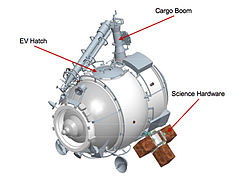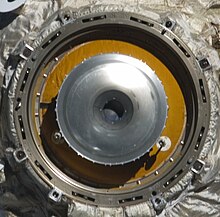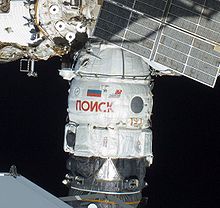 Poisk attached to the ISS prior to the separation of its propulsion unit Poisk attached to the ISS prior to the separation of its propulsion unit | |
| Module statistics | |
|---|---|
| Part of | International Space Station |
| Launch date | 10 November 2009, 02:22 UTC |
| Launch vehicle | Soyuz-U / Progress No. 302 |
| Docked | 12 November 2009, 15:41 UTC (Zvezda zenith) |
| Mass | 3,670 kg (8,090 lb) |
| Length | 4.049 m (13.28 ft) |
| Diameter | 2.55 m (8 ft 4 in) |
| Pressurised volume | 14.8 m (520 cu ft) |
| Configuration | |
 Diagram of the Poisk module | |
Poisk (Russian: Поиск, lit. 'Search'), also known as the Mini-Research Module 2 (MRM 2, Russian: Малый исследовательский модуль 2), is a docking module of the International Space Station (ISS). Added in 2009, Poisk was the first major Russian addition to the International Space Station since 2001. Poisk is overall the same design as the docking module Pirs. Whereas Pirs was attached to the nadir ("bottom") port of Zvezda, Poisk is attached to the zenith ("top"); Pirs was closer to the Earth with the ISS in its usual orientation, and Poisk is on the other side. Poisk is Russian for explore or search. Poisk combines various docking, EVA, and science capabilities. It has two egress hatches for EVAs in addition to the two spacecraft docking ports. Although Poisk is designated as Mini-Research Module 2, it arrived before Mini-Research Module 1 (Rassvet), which had a different design; Poisk looks more like the Pirs docking port, which is not designated as a mini-research module.
Details

Poisk docked to the zenith port of the Zvezda module on 12 November 2009, and serves as a docking port for Soyuz and Progress spacecraft and as an airlock for spacewalks. Poisk will also provide extra space for scientific experiments, and provide power-supply outlets and data-transmission interfaces for two external scientific payloads to be developed by the Russian Academy of Sciences.

Two spacewalks conducted from the ISS in June 2009, successfully completed activities anticipating Poisk module's future berthing.
On 5 June 2009, during Russian Orlan EVA-22 spacewalk Expedition 19/20 Commander Gennady Padalka and Flight Engineer Michael Barratt installed two Kurs docking antennas, a docking target and electrical connectors on the exterior of Zvezda's Service Module.
On 10 June 2009, during Russian Orlan EVA-23 spacewalk Padalka and Barratt replaced a flat hatch cover in the forward section of Zvezda with a standard conical docking cone cover to allow for Poisk's docking.
On 14 January 2010, cosmonauts Oleg Kotov and Maksim Suraev conducted a spacewalk to outfit the Poisk module to prepare for receiving Soyuz and Progress ships in the future. They deployed antennas and a docking target, installed two handrails and plugged the new module's Kurs antennas into the Kurs docking system circuitry. The spacewalk lasted five hours and 44 minutes.
On 21 January 2010, the module was first used when cosmonaut Suraev and Expedition 22 commander Jeffrey Williams relocated their Soyuz TMA-16 spacecraft from the aft port of the Zvezda module to the zenith-facing port of the Poisk module. The Soyuz TMA-16 spacecraft undocked from the aft end of the Zvezda service module at 10:03 UTC and backed away to a distance of about 30m (100 feet) from the space station. Undocking occurred as the station flew about 343 km (213 miles) high off the southwest coast of Africa. Re-docking occurred at 10:24 UTC after Suraev fired the Soyuz maneuvering thrusters to fly halfway around the orbiting space station and line up with the Poisk module.
Since the EVA on 18 November 2020, Poisk has been used for EVAs instead of the decommissioned Pirs Docking Compartment. In future, it will be standard practice to dock Soyuz vehicles to the nadir ports of Rassvet and Prichal and dock Progresses to the aft port of Zvezda and the zenith port of Poisk. This is because the transfer chamber which connects to Zvezda’s aft port has a small leak which requires the hatches to remain closed as much as possible, which would block access to a Soyuz if it were docked to Zvezda’s aft port. In addition, Progress crafts are preferred for Zvezda’s aft port as this enables them to perform ISS reboosts using their main engines. Progresses are also preferred for the Poisk zenith port as Poisk is now serving as the Russian Segment's airlock following the departure of Pirs, and access to Soyuz craft docked to Poisk is blocked whilst Poisk is depressurized during spacewalks, which presents safety issues in an ISS evacuation scenario.
Design and construction
The module was designed and manufactured by S.P. Korolev RSC Energia, the organization engaged in the development and operational use of the ISS Russian segment.
Launch
 Poisk arriving at the ISS
Poisk arriving at the ISS The propulsion compartment of the Poisk module departs
The propulsion compartment of the Poisk module departs
The module was launched on 10 November 2009, 2:22 p.m. GMT attached to a modified Progress spacecraft, called Progress M-MIM2, on a Soyuz-U rocket from Launch Pad 1 at the Baikonur Cosmodrome in Kazakhstan. The occasion also marked the 1750th launch of a Soyuz rocket in its various configurations. About eight minutes after launch, the three-stage Soyuz rocket delivered Poisk, to a low-altitude injection orbit. According to NASA Poisk carried about 816 kg (1,799 lb) of cargo to the ISS including new Russian Orlan spacesuits, life support equipment, medical supplies and crew hygiene items.
The Progress space tug provided electrical power and propulsion for the Poisk module during its two-day journey to the space station. On 12 November, Progress began its automated final approach to the station on a Kurs rendezvous radar system and at 15:41 UTC Poisk docked to the Zvezda module's zenith port. The docking happened as the space station sailed more than 354km (220 miles) over northern Kazakhstan.
Cosmonauts Maksim Suraev and Roman Romanenko entered the module for the first time by opening the hatch leading into Poisk at 12:17 UTC on 13 November 2009.
The jettisoning of the Progress ship from the Poisk module happened around 8 December 2009. The Progress was destroyed during re-entry into the atmosphere.
Specifications

| Designation | 240GK No. 2L |
| Launch mass | 3670 kg ± 50 kg |
| Maximum hull diameter | 2.55 m |
| Hull length between docking assembly planes | 4.049 m |
| Pressurized volume | 14.8 m |
| Habitable volume | 10.7 m |
| Number of egress hatches (open inward) | 2 |
| Egress hatch diameter | 1 m |
| Mass of delivered cargoes | up to 1000 kg |
False depressurization alarm
False alarms woke the crews aboard space shuttle Atlantis and the Space Station at 01:36 UTC on 20 November 2009 and once again at 02:53 UTC on 21 November. An erroneous indication of a rapid depressurization led to the automatic shutdown of ventilation fans throughout the station, which stirred up dust and led to a false smoke detection alarm in the European Space Agency's Columbus laboratory. Mission control Capcom Frank Lien in Houston told the Expedition 21 Commander Frank De Winne that it might have originated from the Poisk module.
Visiting spacecraft
| Spacecraft | Docking (UTC) | Undocking (UTC) |
|---|---|---|
| Soyuz TMA-16 | 21 January 2010, 05:24 | 18 March 2010, 08:03 |
| Soyuz TMA-18 | 4 April 2010, 05:25 | 25 September 2010, 02:02 |
| Soyuz TMA-01M | 10 October 2010, 00:01 | 16 March 2011, 04:27 |
| Soyuz TMA-21 | 6 April 2011, 23:09 | 16 September 2011, 00:38 |
| Soyuz TMA-22 | 16 November 2011, 05:24 | 27 April 2012, 08:15 |
| Soyuz TMA-04M | 17 May 2012, 04:36 | 16 September 2012, 23:09 |
| Soyuz TMA-06M | 25 October 2012, 12:29 | 15 March 2013, 23:43 |
| Soyuz TMA-08M | 29 March 2013, 02:28 | 10 September 2013, 23:27 |
| Soyuz TMA-10M | 26 September 2013, 02:45 | 11 March 2014, 00:02 |
| Soyuz TMA-12M | 27 March 2014, 23:53 | 10 September 2014, 23:01 |
| Soyuz TMA-14M | 26 September 2014, 02:11 | 11 March 2015, 22:44 |
| Soyuz TMA-16M | 28 March 2015, 01:33 | 11 September 2015, 21:29 |
| Soyuz TMA-18M | 4 September 2015, 07:42 | 2 March 2016, 01:05 |
| Soyuz TMA-20M | 19 March 2016, 03:09 | 16 September 2016, 21:51 |
| Soyuz MS-02 | 21 October 2016, 09:52 | 10 April 2017, 07:57 |
| Soyuz MS-04 | 20 April 2017, 13:18 | 2 September 2017, 21:58 |
| Soyuz MS-06 | 13 September 2017, 02:55 | 27 February 2018, 23:08 |
| Soyuz MS-08 | 23 March 2018, 20:40 | 4 October 2018, 07:57 |
| Soyuz MS-11 | 3 December 2018, 17:33 | 24 June 2019, 23:25 |
| Soyuz MS-13 | 26 August 2019, 03:59 | 6 February 2020, 05:50 |
| Soyuz MS-16 | 9 April 2020, 14:13 | 21 October 2020, 11:32 |
| Soyuz MS-17 | 19 March 2021, 17:12 | 17 April 2021, 01:34 |
| Soyuz MS-20 | 8 December 2021, 13:41 | 20 December 2021, 23:50 |
| Soyuz MS-23 | 26 February 2023, 00:58 | 6 April 2023, 08:45 |
Gallery (exterior)
-
 ISS crewmember attached to exterior of Poisk during an EVA
ISS crewmember attached to exterior of Poisk during an EVA
-
 Poisk approaching the ISS for docking
Poisk approaching the ISS for docking
-
 The Russian Orbital Segment - MRM-2 below upper Soyuz
The Russian Orbital Segment - MRM-2 below upper Soyuz
-
 The location of MRM-2 and other modules on the Russian Orbital Segment
The location of MRM-2 and other modules on the Russian Orbital Segment
Gallery (interior)
-
 Yelena Serova works on an experiment in Poisk
Yelena Serova works on an experiment in Poisk
-
 ISS crew inspect the new module's interior on Earth
ISS crew inspect the new module's interior on Earth
-
 Plasma Crystal experiment 3 in Poisk
Plasma Crystal experiment 3 in Poisk
-
 Maksim Surayev next to two Orlan-MK spacsuits in Poisk.
Maksim Surayev next to two Orlan-MK spacsuits in Poisk.
Diagram

See also
References
- "Docking Compartment-1 and 2". Retrieved 26 March 2009.
- "Archived copy" (PDF). Archived from the original (PDF) on 1 February 2017. Retrieved 1 January 2017.
{{cite web}}: CS1 maint: archived copy as title (link) - "New Russian Module Poised to Launch Toward Space Station". Space.com. 9 November 2009.
- "Spaceflight Now | Breaking News | Poisk module adds room to International Space Station".
- "Spaceflight Now | Breaking News | Poisk module adds room to International Space Station".
- "Spaceflight Now | Breaking News | Poisk module adds room to International Space Station".
- NASA (5 June 2009). "ISS On-Orbit Status 06/05/09". Retrieved 11 November 2009.
- NASA (10 June 2009). "ISS On-Orbit Status 06/10/09". Retrieved 11 November 2009.
- NASA (14 January 2010). "Station Crew Completes First Expedition 22 Spacewalk". Retrieved 16 January 2010.
- NASA (14 January 2010). "ISS On-Orbit Status 01/14/10". Retrieved 16 January 2010.
- Stephen Clark (21 January 2010). "Crew shifts Soyuz capsule to new station docking port". Spaceflightnow.com. Retrieved 21 January 2010.
- Harding, Pete (29 July 2021). "MLM Nauka docks to ISS, malfunctions shortly thereafter". NASASpaceFlight.com. Retrieved 30 July 2021.
- "International Space Station". RSC Energia. 16–17 June 2009.
- NASA. "New Russian Module "Poisk" On Its Way to Station". Retrieved 11 November 2009.
- "FAWG Planning Manifest" (Press release). NASA/NASASpaceflight.com. 17 November 2008.
- "August 28, 2009. S.P.Korolev RSC Energia, Korolev, Moscow region". RSC Energia. 28 August 2009. Retrieved 3 September 2009.
- Stephen Clark (10 November 2009). "Poisk launches to add new room for space station". spaceflightnow.com. Retrieved 11 November 2009.
- "Success of the 1750th launch of Soyuz". STARSEM The Soyuz Company. 10 November 2009. Retrieved 10 May 2010.
- New Russian module docks to station
- "Mini-Research Module-2 Poisk". Kosmonavtka. Archived from the original on 28 July 2012. Retrieved 24 November 2009.
- William Harwood (19 November 2009). "Crews awakened by false fire, depressurization alarms". Retrieved 20 November 2009.
- William Harwood (20 November 2009). "Astronauts awakened a second night by false alarms". spaceflightnow.com. Retrieved 21 November 2009.
External links
| Components of the International Space Station | ||||||||||
|---|---|---|---|---|---|---|---|---|---|---|
| Orbiting |
|  | ||||||||
| Former |
| |||||||||
| Future |
| |||||||||
| Spare hardware | ||||||||||
| Cancelled | ||||||||||
| Related | ||||||||||
| ← 2008Orbital launches in 20092010 → | |
|---|---|
| January | |
| February | |
| March | |
| April | |
| May | |
| June | |
| July | |
| August | |
| September | |
| October | |
| November | |
| December | |
| Launches are separated by dots ( • ), payloads by commas ( , ), multiple names for the same satellite by slashes ( / ). Crewed flights are underlined. Launch failures are marked with the † sign. Payloads deployed from other spacecraft are (enclosed in parentheses). | |